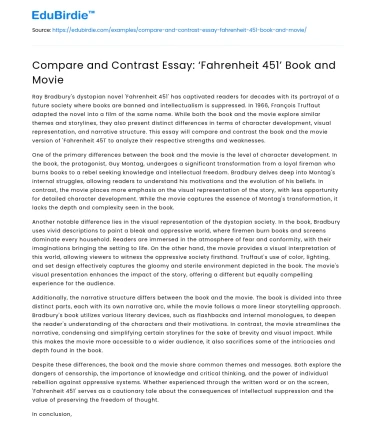Ray Bradbury's dystopian novel 'Fahrenheit 451' has captivated readers for decades with its portrayal of a future society where books are banned and intellectualism is suppressed. In 1966, François Truffaut adapted the novel into a film of the same name. While both the book and the movie explore similar themes and storylines, they also present distinct differences in terms of character development, visual representation, and narrative structure. This essay will compare and contrast the book and the movie version of 'Fahrenheit 451' to analyze their respective strengths and weaknesses.
One of the primary differences between the book and the movie is the level of character development. In the book, the protagonist, Guy Montag, undergoes a significant transformation from a loyal fireman who burns books to a rebel seeking knowledge and intellectual freedom. Bradbury delves deep into Montag's internal struggles, allowing readers to understand his motivations and the evolution of his beliefs. In contrast, the movie places more emphasis on the visual representation of the story, with less opportunity for detailed character development. While the movie captures the essence of Montag's transformation, it lacks the depth and complexity seen in the book.
Save your time!
We can take care of your essay
- Proper editing and formatting
- Free revision, title page, and bibliography
- Flexible prices and money-back guarantee
Another notable difference lies in the visual representation of the dystopian society. In the book, Bradbury uses vivid descriptions to paint a bleak and oppressive world, where firemen burn books and screens dominate every household. Readers are immersed in the atmosphere of fear and conformity, with their imaginations bringing the setting to life. On the other hand, the movie provides a visual interpretation of this world, allowing viewers to witness the oppressive society firsthand. Truffaut's use of color, lighting, and set design effectively captures the gloomy and sterile environment depicted in the book. The movie's visual presentation enhances the impact of the story, offering a different but equally compelling experience for the audience.
Additionally, the narrative structure differs between the book and the movie. The book is divided into three distinct parts, each with its own narrative arc, while the movie follows a more linear storytelling approach. Bradbury's book utilizes various literary devices, such as flashbacks and internal monologues, to deepen the reader's understanding of the characters and their motivations. In contrast, the movie streamlines the narrative, condensing and simplifying certain storylines for the sake of brevity and visual impact. While this makes the movie more accessible to a wider audience, it also sacrifices some of the intricacies and depth found in the book.
Despite these differences, the book and the movie share common themes and messages. Both explore the dangers of censorship, the importance of knowledge and critical thinking, and the power of individual rebellion against oppressive systems. Whether experienced through the written word or on the screen, 'Fahrenheit 451' serves as a cautionary tale about the consequences of intellectual suppression and the value of preserving the freedom of thought.
In conclusion, 'Fahrenheit 451' by Ray Bradbury and its film adaptation by François Truffaut offer distinct yet complementary experiences for audiences. The book provides in-depth character development, immersive descriptions, and a multi-layered narrative structure. On the other hand, the movie captivates with its visual representation of the dystopian world and a streamlined storytelling approach. While the book delves deeper into the internal struggles of the characters, the movie visually portrays the oppressive society depicted in the novel. Both versions successfully convey the powerful themes of censorship, knowledge, and rebellion. Whether one prefers the richness of the book or the visual impact of the movie, both mediums have their own merits, making 'Fahrenheit 451' a remarkable work in both literary and cinematic realms.






 Stuck on your essay?
Stuck on your essay?

